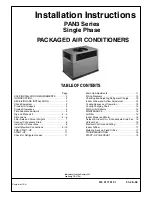
8
Step 6—Connect Condensate Drain
NOTE
: When installing condensate drain connection be
sure to comply with local codes and restrictions.
The PAN3 disposes of condensate water through a 3/4 in.
NPT fitting which exits through the base on the evaporator
coil access side. See Fig. 3 & 4 for location.
Condensate water can be drained directly onto the roof in
rooftop installations (where permitted) or onto a gravel
apron in ground level installations. Install a field--supplied
2--in. condensate trap at the end of condensate connection
to ensure proper drainage. Make sure that the outlet of the
trap is at least 1 in. lower than the drain--pan condensate
connection to prevent the pan from overflowing (See Fig. 6).
Prime the trap with water. When using a gravel apron, make
sure it slopes away from the unit.
Connect a drain tube using a minimum of 3/4--in. PVC or
3/4--in. copper pipe (all field--supplied) at the outlet end of
the 2--in. (51mm) trap. Do not undersize the tube. Pitch the
drain tube downward at a slope of at least 1--in. (25mm) for
every 10 ft (3048mm) of horizontal run. Be sure to check the
drain tube for leaks.
FIGURE 6
Condensate Drain
TRAP
OUTLET
2" min.
1" min.
Step 7—Select and Install Duct Connections
The design and installation of the duct system must be in
accordance with the standards of the NFPA for installation
of non--residence type air conditioning and ventilating
systems, NFPA 90A or residence type, NFPA 90B and/or
local codes and ordinances.
Select and size ductwork, supply--air registers, and return
air grilles according to ASHRAE (American Society of
Heating, Refrigeration, and Air Conditioning Engineers)
recommendations. The unit has duct flanges on the supply--
and return--air openings on the side of the unit.
When designing and installing ductwork, consider the
following:
1. All units should have field--supplied filters or accessory
filter rack installed in the return--air side of the unit.
Recommended sizes for filters are shown in Table 1.
2. Avoid abrupt duct size increases and reductions.
Abrupt change in duct size adversely affects air
performance.
IMPORTANT
: Use flexible transitions between ductwork
and unit to prevent transmission of vibration. Use suitable
gaskets to ensure weather tight and airtight seal. When
electric heat is installed, use fireproof canvas (or similar
heat resistant material) connector between ductwork and
unit discharge connection. If flexible duct is used, insert a
sheet metal sleeve inside duct. Heat resistant duct
connector (or sheet metal sleeve) must extend 24--in. from
electric heater element.
3. Size ductwork for cooling air quantity (cfm). The
minimum air quantity for proper electric heater
operation is listed in Table 2. Heater limit switches may
trip at air quantities below those recommended.
4. Seal, insulate, and weatherproof all external ductwork.
Seal, insulate and cover with a vapor barrier all
ductwork passing through conditioned spaces. Follow
latest Sheet Metal and Air Conditioning Contractors
National Association (SMACNA) and Air Conditioning
Contractors Association (ACCA) minimum installation
standards for residential heating and air conditioning
systems.
5. Secure all ducts to building structure. Flash,
weatherproof, and vibration--isolate duct openings in
wall or roof according to good construction practices.
CONFIGURING UNITS FOR DOWNFLOW (VERTICAL)
DISCHARGE
ELECTRICAL SHOCK HAZARD
Failure to follow this warning could result in personal
injury or death.
Before installing or servicing system, turn off the power
supply to the unit and install lockout tag. There may be
more than one disconnect switch.
!
WARNING
1. Open all electrical disconnects before starting any
service work.
2. Remove return duct cover located on duct panel by
breaking four (4) connecting tabs with screwdriver and
a hammer (see Fig. 7 & 8).
3. To remove supply duct cover, break front and right side
connecting tabs with a screwdriver and a hammer.
Push louver down to break rear and left side tabs (see
Fig. 7 & 8).
4. If unit ductwork is to be attached to vertical opening
flanges on the unit base (jackstand applications only),
do so at this time. Collect ALL screws that were
removed. Do not leave screws on rooftop, as
permanent damage to the roof may occur.
PROPERTY DAMAGE HAZARD
Failure to follow this caution may result in property
damage.
Collect ALL screws that were removed.
Do not
leave
screws on rooftop as permanent damage to the roof
may occur.
CAUTION
!
5. It is recommended that the base insulation around the
perimeter of the vertical return--air opening be secured
to the base with aluminum tape. Applicable local codes
may require aluminum tape to prevent exposed
fiberglass.
6. Cover both horizontal duct openings with the provided
duct covers. Ensure opening is air and water tight.
7. After completing unit conversion, perform all safety
checks and power up unit.



















